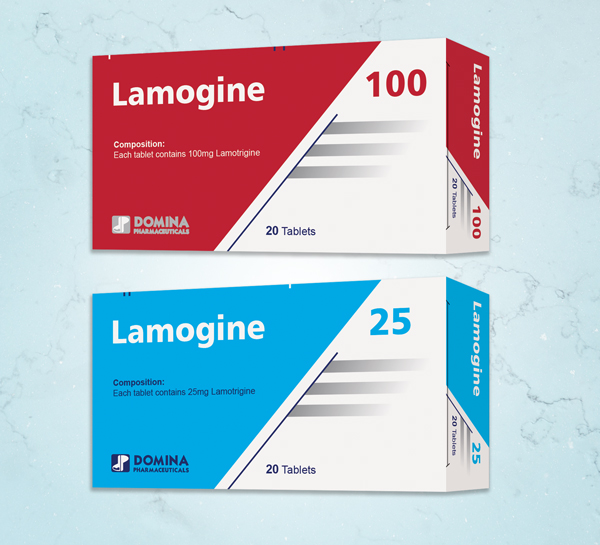
COMPOSITION:
Each tablet contains 25, or 100mg Lamotrigine
MECHANISM OF ACTION:
LAMOGINE inhibit the voltage dependent sodium currents, stabilizes the nervous membranes, reduces the sustained repetitive firing of neuronal activity, LAMOGINE inhibits the pathological release of glutamate, the amino acid which plays a key role in the generation of epileptic seizure.
INDICATIONS:
Epilepsy in Monotherapy in adults for Simple partial seizures, complex partial seizures, secondarily generalized tonic clonic seizures, Primary generalized tonic clonic seizures.
Add-on therapy in adults and children over 2 years of age for the same mentioned illness and treatment of seizures associated with Lennox-Gastaut Syndrome.
DOSAGE:
LAMOGINE therapy should be initiated slowly and gradually increased.
The drug should be gradually decreased (during 2 weeks), when it is to be discontinued, to prevent rebound seizures. There is insufficient information on the use of the drug in children aged less than 2 years.
Children 2-12 years:
|
Treatment |
Weeks 1 - 2 |
Weeks 3 - 4 |
Usual maintenance dose |
|
Monotherapy |
The drug should not be used on monotherapy treatment in children 2-12 years |
||
|
Combined therapy with Valproate with/without any other enzyme inducing AEDs* |
0.2mg/kg once daily |
0.5mg/kg once daily |
1-5mg/kg once daily or in two divided doses (To achieve maintenance doses, may be increased by 0.5-1mg/kg every 1-2 weeks) |
|
Combined therapy with enzyme inducing AEDs with/without other AEDs except valproate |
2mg/kg daily in two divided doses |
5mg/kg daily in two divided doses |
5-15mg/kg daily in two divided doses (To achieve maintenance doses, may be increased by 2-3mg/kg every 1-2 weeks) |
* Enzyme inducing AEDs e.g. phenytoin, carbamazepine, phenobarbitone and primidone.
Adults (and children over 12 years):
|
Treatment |
Weeks 1 - 2 |
Weeks 3 - 4 |
Usual maintenance dose |
|
Monotherapy |
25mg once daily |
50mg once daily |
100-200mg once daily or in two divided doses (To achieve maintenance doses, may be increased by 50-100mg every 1-2 weeks) |
|
Combined therapy with Valproate with/without any other enzyme inducing AEDs |
12.5mg once daily, given as 25mg on alternate days |
25mg once daily |
100-200mg once daily or in two divided doses (To achieve maintenance doses, may be increased by 25-50mg every 1-2 weeks) |
|
Combined therapy with enzyme inducing AEDs with/without other AEDs except valproate |
50mg once daily |
100mg daily in two divided doses |
200-400mg daily in two divided doses (To achieve maintenance doses, may be increased by 100mg every 1-2 weeks) |
SIDE-EFFECTS:
It may occur: Headache, nausea, diplopia, blurred vision, aggression, haematologica including leucopenia and thrombocytopenia. It may cause severe rash. The risk of rash is lower with slower titration rates. Patients should be counseled to contact their physician at the first sign of rash. In many cases the rash disappears during continued therapy, except 1 – 2% of patients with rash represent more serious allergic reaction. Occasionally patients have developed the Stevens Johnson syndrome.
CONTRA-INDICATIONS:
Hypersensitivity to the drug.
DRUG-INTERACTIONS:
Concomitant administration of carbamazepine with LAMOGINE decreases LAMOGINE concentration by 70%. Concomitant administration of phenobarbital or primidone with LAMOGINE decreases concentration of LAMOGINE by 40%. Concomitant administration of valproic acid with LAMOGINE increases LAMOGINE concentration twofold. The half-life of LAMOGINE is increased from 24 to 59 hrs by concomitant administration of valproic acid.
PRECAUTIONS:
- Caution should be used by patients having renal, hepatic or cardiac impairment.
- Patients should be taken protective measures against exposure to sunlight to prevent photosensitization.
- LAMOGINE binds to melanin and can accumulate in melanin-rich tissue. Over time periodic ophthalmological monitoring is recommended.
- The value of monitoring plasma concentration has not been established.
Pharmacokinetics:
Orally administrated LAMOGINE is rapidly and completely absorbed Tmx is 1.5 hours in fasted subjects and 3 hours in fed subjects, as food delays absorption but does not affect bioavailability. Its binding to plasma proteins is about 55%. The mean elimination half-life is 24–35 hours.
Use in Pregnancy or Lactation:
LAMOGINE is a weak dihydrofolate reductase inhibitor. It should be avoided in pregnancy unless compelling circumstances demand so. It should not be used during lactation.